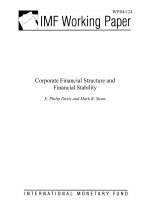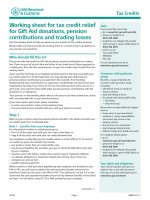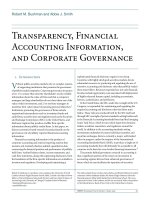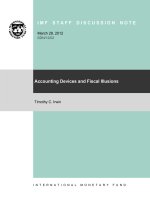ACCOUNTING FOR REVENUE AND OTHER FINANCING SOURCES AND CONCEPTS FOR RECONCILING BUDGETARY AND FINANCIAL ACCOUNTING ppt
Bạn đang xem bản rút gọn của tài liệu. Xem và tải ngay bản đầy đủ của tài liệu tại đây (513.83 KB, 185 trang )
FASAB
ACCOUNTING FOR REVENUE
AND
OTHER FINANCING SOURCES
AND
CONCEPTS FOR RECONCILING
BUDGETARY AND FINANCIAL ACCOUNTING
Statement of Recommended Accounting Standards Number 7
April 1996
______________________________________________________
______________________________________________________
APPLICABILITY, MATERIALITY, AND TERMINOLOGY
These standards apply to general purpose financial reports of
U.S. Government reporting entities. These standards need not be
applied to immaterial items unless otherwise noted. Statement of
Federal Financial Accounting Concepts No. 2 (SFFAC No. 2),
Entity and Display, lists criteria for defining Government
reporting entities. Paragraph 78 of Entity and Display notes
that some of a reporting entity's components may be required by
law or policy to issue financial statements in accordance with
accounting standards other than those recommended by the FASAB
and issued by the OMB and the GAO, e.g., accounting standards
issued by the Financial Accounting Standards Board or by a
regulatory agency. Those components should continue to issue the
required reports. The reporting entities of which the components
are a part, however, need to be sensitive to differences that
may arise because of different accounting standards. If these
differences are material, the standards recommended by the FASAB
and issued by the OMB and the GAO should be applied. The
components would need to provide any additional disclosures or
different recognition and measurement required by the accounting
standards issued by the OMB and the GAO that are not required by
other standards.
"Disclosure" in this document indicates providing information in
notes or narrative regarded as an integral part of the basic
financial statements. "Supplementary" indicates providing
information that is regarded as "required supplementary
information" as that term is used in accounting and auditing
standards. The limited auditing procedures for this information
are defined in auditing standards. "Other accompanying
information" refers to unaudited information that accompanies
the audited financial statements. It is not regarded as
essential for "fair presentation." Another kind of supplementary
information is "Required Supplementary Stewardship Information."
This is a proposed category unique to Federal Government
accounting and auditing standards. It refers to certain
information for which FASAB expects OMB and GAO in collaboration
to agree upon appropriate auditing procedures. It will be
regarded as essential for "fair presentation."
______________________________________________________
STATEMENT OF FEDERAL FINANCIAL
ACCOUNTING STANDARDS NUMBER 7
PREFACE
i
EXECUTIVE SUMMARY
1
ACCOUNTING STANDARDS FOR REVENUE AND OTHER FINANCING SOURCES
1
SCOPE
1
CLASSIFICATION, RECOGNITION, AND MEASUREMENT
1
DISCLOSURES, SUPPLEMENTARY INFORMATION, AND OTHER
INFORMATION
4
CONCEPTS FOR RECONCILING BUDGETARY AND FINANCIAL ACCOUNTING
4
PART I: ACCOUNTING
FOR REVENUE AND
OTHER FINANCING SOURCES
INTRODUCTION
6
BACKGROUND
6
MATERIALITY
10
EFFECTIVE DATE
10
ACCOUNTING STANDARDS
11
SCOPE
11
EXCHANGE REVENUE
11
RECOGNITION AND MEASUREMENT OF EXCHANGE REVENUE
12
DISCLOSURES AND OTHER ACCOMPANYING INFORMATION
16
NONEXCHANGE REVENUE
17
RECOGNITION AND MEASUREMENT
OF NONEXCHANGE REVENUE
17
The General Standard
17
Taxes and Duties
17
Fines and Penalties
23
Donations
24
Other Nonexchange Revenue
24
DISCLOSURES, SUPPLEMENTARY INFORMATION, AND OTHER
ACCOMPANYING INFORMATION
24
Disclosures
24
______________________________________________________
Supplementary Information
26
Other Accompanying Information
27
OTHER FINANCING SOURCES
28
RECOGNITION AND MEASUREMENT OF OTHER FINANCING SOURCES
29
Appropriations
29
Financing Imputed for Cost Subsidies
29
Transfers of Assets
30
PRIOR PERIOD ADJUSTMENTS
30
BUDGETARY INFORMATION
31
ACCOUNTABILITY FOR DEDICATED COLLECTIONS
33
PART II: CONCEPTS FOR RECONCILING BUDGETARY AND FINANCIAL
ACCOUNTING
36
INTRODUCTION
36
AMENDMENTS TO SFFAC No. 2, ENTITY AND DISPLAY
36
RECONCILIATION STATEMENT BUDGETARY AND FINANCIAL
ACCOUNTING
37
STATEMENT OF FINANCING
37
Entity and Display, Appendix 1-G
39
APPENDICES
40
APPENDIX A: BASIS FOR CONCLUSIONS
40
EXCHANGE REVENUE
42
Special Nature of Government Exchange Transactions
42
Recognition: General Considerations
43
Recognition: Special Cases
49
Measurement
58
NONEXCHANGE REVENUE
61
Inherent Limitations
61
Practical Limitations
62
Modified Cash Basis for Taxes and Duties
63
Cash Basis Information Needed
63
Potential Changes
63
Entities Responsible for Measuring and Recognizing
Revenue
64
Possible Over- and Under-funding of Trust Funds
64
Conceptual Criteria for Accrual and Limitations on
Their Application
65
Limitations on the Scope of Accounting
67
Some Benefits of this Standard
67
Some Things this Standard Does Not Accomplish
68
Accounting Systems Changes
69
Disclosures, Supplementary Information, and Other
______________________________________________________
Accompanying Information
70
Tax Gap
73
Tax Expenditures
75
Directed Flows of Resources
76
OTHER FINANCING SOURCES AND BUDGETARY RESOURCES
78
General Principles
78
Reducing Differences
79
The Budgetary Process and Its Linkage to
Accounting
80
Implications of the term "Net Results of
Operations"
85
DEDICATED COLLECTIONS
86
APPENDIX B: GUIDANCE FOR THE CLASSIFICATION OF TRANSACTIONS
90
INTRODUCTION
90
TABLE OF TRANSACTIONS. . . . . . . . . . . . . . . . . . 93
TRANSACTIONS WITH THE PUBLIC
97
Nonexchange Transactions With The Public
97
Exchange Transactions With The Public: Revenue
107
Exchange Transactions With The Public: Gains And
Losses
115
Other Financing Sources From The Public
118
INTRAGOVERNMENTAL TRANSACTIONS
119
Nonexchange Transactions Intragovernmental:
Revenue
119
Nonexchange Transactions Intragovernmental: Gains
And Losses
121
Exchange Transactions Intragovernmental: Revenue
122
Exchange Transactions Intragovernmental: Gains
And Losses
127
Other Financing Sources Intragovernmental
128
REVALUATIONS
133
TRANSACTIONS NOT RECOGNIZED AS REVENUES, GAINS, OR
OTHER FINANCING SOURCES
134
APPENDIX C: GLOSSARY
141
INDEX OF TRANSACTIONS
149
LIST OF ABBREVIATIONS
151
______________________________________________________
PREFACE
This document contains two separate parts. The first, on revenue
and other financing sources, is composed of the introduction,
accounting standards, and appendices. After the standards
recommended by FASAB are approved by the Secretary of the
Treasury, the Director of the Office of Management and Budget,
and the Comptroller General and are published, the standards
provide authoritative guidance to those who prepare and audit
general purpose financial reports of U.S. Government entities.
The second part of this document amends Statement of Federal
Financial Accounting Concepts No. 2, Entity and Display, by
adding a new concept to satisfy users' needs for information that
reconciles budgetary and financial accounting. This concept is
presented in the section of this document that begins on page
Error! Bookmark not defined.
. Statements of Federal Financial
Accounting Concepts articulate the framework within which the
Board considers and recommends accounting standards. Statements
of concepts do not provide authoritative guidance to preparers
and auditors.
______________________________________________________
EXECUTIVE SUMMARY
ACCOUNTING STANDARDS FOR REVENUE AND OTHER
FINANCING SOURCES
SCOPE
1. This Statement presents standards to
account for inflows of resources from revenue
and other financing sources. It provides
standards for classifying, recognizing, and
measuring resource inflows. These financial
(proprietary) accounting standards differ
from those used for budgetary accounting only
to the extent essential to meet the
Objectives of Federal Financial Reporting.
CLASSIFICATION, RECOGNITION, AND
MEASUREMENT
2. Revenue is an inflow of resources that the
Government demands, earns, or receives by
donation. Revenue comes from two sources:
exchange transactions and nonexchange
transactions. Exchange revenues arise when a
Government entity provides goods and services
to the public or to another Government entity
for a price. Another term for "exchange
revenue" is "earned revenue." Nonexchange
revenues arise primarily from exercise of the
Government's power to demand payments from
the public (e.g., taxes, duties, fines, and
penalties) but also include donations. The
term "revenue" does not encompass all
financing sources of Government reporting
entities, such as most of the appropriations
they receive. These other sources of
financing do, however, provide resource
inflows to Government reporting entities, so
this Statement includes accounting standards
for them.
3. These accounting standards recognize
exchange revenue at the time that a
Government entity provides goods or services
to the public or to another Government
entity. The revenue is measured at the price
2 SFFAS No. 7
______________________________________________________
likely to be received. Thus, with some
differences that are explained in the
standard, the accounting for earned revenue
is comparable to the private sector's accrual
accounting for earned revenue. Exchange
revenue includes most user charges other than
taxes. Such user charges include regulatory
user charges, in which the exchange is not
wholly voluntary but the revenue is
generally, but not always, related to the
cost of providing service to identifiable
groups. One example is the revenue derived
from the Securities and Exchange Commission's
registration fees. Exchange transactions also
include those intragovernmental transactions
where the price serves as a full or partial
reimbursement for the costs incurred.
4. Distinguishing exchange revenue from non-
exchange revenue and other financing sources
enables the entity to report the net cost of
operations of its programs (and the cost of
the entity to the taxpayer) and provides the
accounting foundation to report unit cost of
output measures for performance evaluations.
Requiring that exchange revenue be matched
with the cost of outputs of goods and
services sold to the public enables the
entity to report the cost to the taxpayer of
not charging the full cost of those goods and
services.
5. Nonexchange revenues include income taxes,
excise taxes, duties, fines, penalties, and
other inflows of resources arising from the
Government's power to demand payments, as
well as voluntary donations. Nonexchange
revenue is recognized when a reporting entity
establishes a specifically identifiable,
legally enforceable claim to cash or other
assets. It is recognized to the extent that
the collection is probable (i.e., more likely
than not) and the amount is measurable (i.e.,
reasonably estimable).
1
6. In the case of taxes and duties, inherent and practical limitations
on the assessment process serve to delay the time when the power
EXECUTIVE SUMMARY 3
______________________________________________________
to demand payment becomes a legally enforceable claim to cash or
other assets. For this reason, the method of accounting for taxes
and duties can best be characterized as a modified cash basis of
accounting, rather than an accrual basis. This basis of accounting
amends the standard for the recognition of accounts receivable for
taxes and duties. Cash basis tax revenue will continue to be
accounted for as well, because of the fiscal importance of the
information. The accrual accounting required will provide more
accurate and complete information about receivables and refunds
legally receivable and payable and about the components of the
Government's revenue stream. The Board may review the standard
for accrual of taxes and duties after several years. The Board has
provided that in the interim the IRS and Customs may on their own
initiative modify this standard so that it reflects a fuller application
of the accrual concept.
7. Budgetary resources are recognized from two perspectives: the
proprietary accounting perspective and the budgetary perspective.
From the proprietary perspective, appropriations are accounted for
as a financing source when used. Appropriations are used when an
entity has acquired goods and services or has provided benefits and
grants that are authorized to be paid by an appropriation. The
remaining amount of appropriations enacted into law, but not yet
recognized as "appropriations used," is treated as capital, i.e.,
"unexpended appropriations." This treatment parallels the
recognition of expended appropriations during budgetary
execution.
8. To the extent that other standards require that costs not on the
entity's books be imputed to the entity, the standards for other
financing sources require recognition of the corresponding imputed
financing.
9. Financial statements have not previously presented budget
execution information needed by users of those reports.
Furthermore, concerns have been expressed about whether the
budget is being properly executed in all cases. The standards
presented in this document require the presentation and,
consequently, the audit of information about budgetary resources,
the status of those resources, and outlays. The standards also
require a reconciliation of proprietary and budgetary information in
4 SFFAS No. 7
______________________________________________________
a way that helps users relate the two.
DISCLOSURES, SUPPLEMENTARY
INFORMATION, AND OTHER INFORMATION
10. The different types of revenue, and the complexity of
accounting for revenue and other financing sources, increase the
importance of certain disclosures and other information.
11. Extensive disclosures and other information about taxes and
duties compensate to some extent for the limited accruals under the
modified cash basis of accounting. Such disclosures and other
information also provide a better basis for estimating future cash
flows, overseeing the custodial responsibilities given to the tax
collecting entities, and understanding how the tax burden is shared.
12. Certain disclosures are required about exchange transactions
where the full cost of goods and services sold is not recovered.
13. Limited disclosure concerning accountability for dedicated
collections is required for reporting entities responsible for
administering such funds. Supplementary information is required
from those entities and the entities that make the collections in
cases where trust funds may be over- or under-funded in terms of
applicable law.
14. Disclosures are required about the use of borrowing authority
and the status of budgetary resources that may affect future
spending by the entity.
CONCEPTS FOR RECONCILING BUDGETARY AND
FINANCIAL ACCOUNTING
15. This statement amends Statement of Federal Financial
Accounting Concepts No. 2, Entity and Display, by adding a
category of financial information to further satisfy users' needs and
the objectives of financial reporting. More specifically, the
amendment is designed to meet users' need to understand "how
EXECUTIVE SUMMARY 5
______________________________________________________
information on the use of budgetary resources relates to
information on the cost of program operations . . ." (sub-objective
1C). The objective of this new category of information is to
provide an explanation of the differences between budgetary and
financial (proprietary) accounting. This is accomplished by means
of a reconciliation of budgetary obligations and nonbudgetary
resources available to the reporting entity with its net cost of
operations.
6 SFFAS No. 7
______________________________________________________
6
PART I: ACCOUNTING
FOR REVENUE AND
OTHER FINANCING SOURCES
INTRODUCTION
REVENUE AND OTHER FINANCING SOURCES 7
______________________________________________________
BACKGROUND
16. The essential differences among exchange
revenues, nonexchange revenues, and other
financing sources affect the way they are
recognized and measured under the accrual method
of accounting. Properly classifying these inflows
according to their nature, therefore, provides the
basis for applying different accrual accounting
principles. In addition, proper classification is
essential to constructing financial statements
that meet the federal financial reporting
objectives,
2
as they have been described in Statement of Federal
Financial Accounting Concepts No. 2, Entity and Display.
17. To help meet those objectives, classifications were developed to
determine what specific kinds of revenue should be deducted from the cost
of providing goods and services by the reporting entities. Only revenue
classified as exchange revenue should be matched with costs.
Nonexchange revenue and other financing sources are not matched with
costs because they are not earned in the operations process. Because they
are inflows that finance operations, nonexchange revenues and other
financing sources should be classified in accordance with other rules and
should be recognized only in determining the overall financial results of
operations for the period. This differs from the focus used in the private
sector, where the focus is on net income for business organizations, and on
changes in net assets for not-for-profit organizations. It is also a different
focus from that used previously in reporting on U.S. Government
operations. Under the old federal accounting standards, the focus was on
matching all of an entity's financing with incurred expenses to report "net
results of operations" which generally was not useful in evaluating
performance. The new focus is on costs both gross and net which are
useful in evaluating performance on many levels.
8 INTRODUCTION
______________________________________________________
18. The concept of matching costs and revenue has little relevance in
government except where there is an exchange transaction. An exchange
transaction occurs when one party sacrifices value and receives a valuable
good or service in return. The operations of an entity engaged in exchange
transactions produce the revenue earned as well as the associated cost
incurred. Therefore, financial accounting should relate the revenue to the
cost for these transactions. The net effect the gross cost minus the
revenue, or the net cost generally determines the extent to which
taxpayers bear the cost of the operations.
33
19. Information about the net cost of exchange
transactions serves other purposes as well. Net
cost gives one indication of the extent to which
people are willing to make voluntary payments to
acquire goods or services of the kinds that are
sold. It thus can give an indication of the extent
to which people judge the products to have value.
Net cost also can be used in evaluating an
entity's pricing policy.
20. Most importantly of all, both net cost and
gross cost can be compared with outputs and
outcomes in assessing the effectiveness and
efficiency with which resources are used to
achieve results. Such comparisons can be used by
agency management, the President, and the Congress
in making decisions about allocating resources.
These standards, together with those in SFFAS No.
4, Managerial Cost Accounting Concepts and
Standards, provide information essential to
effective implementation of the Government
Management Reform Act, which requires agencies to
report performance measures such as unit cost.
These standards, when applied in the context of
applicable entity and display concepts, will make
federal financial reporting more meaningful to
those concerned with performance measurement.
33
The only major exception is for intragovernmental sales of goods and
services. The extent to which taxpayers bear the costs of these goods and
services depends on whether the goods and services are sold to entities that in
turn sell goods and services to the public, or to entities that are financed by
taxes. The net cost of operations may also be financed by other nonexchange
revenue such as fines, forfeitures, and donations.
REVENUE AND OTHER FINANCING SOURCES 9
______________________________________________________
21. Nonexchange revenue transactions do not
require a Government entity to give value directly
in exchange for the inflow of resources. The
Government does not "earn" the nonexchange
revenue. The cost that nonexchange revenue
finances falls on those who pay the taxes and make
the other nonexchange payments to the Government.
The different character of nonexchange revenues
requires that they be distinguished from exchange
revenues. They should, therefore, be shown in a
way that does not obscure the entity's net cost of
operations.
22. Although Board Members have differing views on
whether social insurance programs result in
exchange or nonexchange transactions, they agree
that social insurance tax revenues should be shown
in the same way as other tax revenues for the
purposes of financial reporting.
34
Social insurance
taxes, like other taxes, are determined by the
Government's power to compel payment. Individuals
and businesses that pay social insurance taxes are
subject to them as a byproduct of their decision
to enter covered employment or engage in a covered
business. Especially for the major, broad-based
social insurance programs Social Security,
Medicare (hospital insurance), and unemployment
compensation the individuals and businesses have
virtually no option except to pay.
23. The main sources of financing for the
Government as a whole are exchange and nonexchange
revenues and borrowing from the public. For
component reporting entities, however, the sources
of financing are provided through the budget and
are largely financing sources other than revenue.
Appropriations and other budget authority provide
an agency with the authority to incur obligations
to acquire goods and services or to provide
benefits and grants. These other financing sources
are not earned by an entity's operations.
Therefore, as with nonexchange revenue, they
should be accounted for in a way that does not
obscure the entity's net cost.
34
See discussion of social insurance programs in FASAB's Exposure Draft,
Supplementary Stewardship Reporting.
10 INTRODUCTION
______________________________________________________
24. Budgetary resources have a different character
than both exchange revenue and nonexchange
revenue. Budgetary inflows should be shown in a
way that reflects two different perspectives: the
proprietary effect and the budgetary effect.
Proprietary accounting treats these resources much
as capital and lines of credit are treated in
private sector accounting, and provides
information about their availability in the
Balance Sheet or in notes. Appropriations are
recognized as capital when enacted into law, while
borrowing authority is disclosed in notes. Because
Government entities are expected to expend capital
from appropriations rather than maintain it, the
accounting for the use of appropriations differs
in this respect from the private sector's
accounting for capital. The accounting for
"appropriations used" has been simplified and
parallels their budgetary effect.
25. The budget provides the principal basis for
planning and controlling obligations and
expenditures by Government entities. Budget
execution tracks the flow of budgetary resources
from the congressional authorizing and
appropriating process, to the apportionment,
allotment, and obligation of the budgetary
resources, to the outlay of cash to satisfy those
obligations. For the most part, obligations and
cash, rather than accrual accounting, are the
bases for budgeting and reporting on budget
execution.
REVENUE AND OTHER FINANCING SOURCES 11
______________________________________________________
26. Those who prepare financial statements have
recognized that accrual accounting and the budget
are complementary. Accrual-basis accounting often
provides better information than cash-basis
accounting for evaluating performance. It can
provide more information for planning and control
of operations. Accrual accounting provides an
understanding of a reporting entity's net position
and cost of operations. U.S. Government financial
statements have not been used for planning and
control as well as they might have been. In part,
this is because accounting standards have not been
fully attuned to the Government's needs and
circumstances. Another important reason is the
continuing primacy of the budget as a financial
planning and control tool. General purpose
financial reports have not presented budget
execution information with the financial
statements in a way that helped users relate these
two important, but different, types of financial
information. The standards presented in this
document provide the basis for reports that can
deal with this problem.
MATERIALITY
27. Except as otherwise noted, the provisions of the accounting standards
in this statement need not be applied to items that are qualitatively and
quantitatively immaterial.
28. The determination of whether an item is material depends on the
degree to which omitting or misstating information about the item makes it
probable that the judgment of a reasonable person relying on the
information would have been changed or influenced by the omission or the
misstatement.
EFFECTIVE DATE
29. The provisions of this statement are effective for reporting periods that
begin after September 30, 1997. Earlier application is encouraged.
______________________________________________________
12
ACCOUNTING STANDARDS
SCOPE
30. These standards determine how a Government reporting entity should
account for inflows of resources from revenue and other financing sources
in its general purpose financial reports. Revenue is an inflow of resources
that the Government demands, earns, or receives by donation. Revenue
comes from two sources: exchange transactions and nonexchange
transactions. Exchange revenues arise when a Government entity provides
goods and services to the public or to another Government entity for a
price. Another term for "exchange revenue" is "earned revenue."
Nonexchange revenues arise primarily from exercise of the Government's
power to demand payments from the public, such as taxes, duties, fines,
and penalties. Nonexchange revenue also includes donations.
31. The term "revenue" does not encompass all financing sources of
Government reporting entities, such as most of the appropriations they
receive. These other sources of financing do, however, provide resource
inflows to Government reporting entities, although not to the Government
as a whole. Accordingly, standards for accounting for these inflows are
also provided.
32. Appendix B, "Guidance for the Classification of Transactions,"
provides authoritative guidance on which transactions should be classified
as exchange transactions and which should be classified as nonexchange
transactions or other financing sources.
EXCHANGE REVENUE
33. Exchange revenue and gains are inflows of resources to a Government
entity that the entity has earned. They arise from exchange transactions,
which occur when each party to the transaction sacrifices value and
receives value in return. That is, exchange revenue arises when a
Government entity provides something of value to the public or another
Government entity at a price.
EXCHANGE REVENUE 13
______________________________________________________
RECOGNITION AND MEASUREMENT OF
EXCHANGE REVENUE
34. Revenue from exchange transactions should be recognized when goods
or services are provided to the public or another Government entity at a
price.
35. When a transaction with the public or another Government entity at a
price is unusual or nonrecurring, a gain or loss should be recognized rather
than revenue or expense so as to differentiate such transactions.
36. Revenue from specific types of exchange transactions should be
recognized as follows:
(a) When services are provided to the public or another Government
entity (except for specific services produced to order under a
contract), revenue should be recognized when the services are
performed.
(b) When specific goods are made to order under a contract (either
short- or long-term), or specific services are produced to order
under a contract (either short- or long-term), revenue should be
recognized in proportion to estimated total cost when goods and
services are acquired to fulfill the contract. If a loss is probable
(more likely than not), revenue should continue to be recognized in
proportion to the estimated total cost and costs should continue to
be recognized when goods and services are acquired to fulfill the
contract. Thus, the loss should be recognized in proportion to total
cost over the life of the contract.
3
(c) When goods are kept in inventory so that they
are available to customers when ordered,
revenue should be recognized when the goods
are delivered to the customer.
14 ACCOUNTING STANDARDS
______________________________________________________
(d) When services are rendered continuously over
time or the right to use an asset extends
continuously over time, such as the use of
borrowed money or the rental of space in a
building, the revenue should be recognized in
proportion to the passage of time or the use
of the asset. The interest received on money
borrowed in an intragovernmental transaction
is an exchange revenue when the source of the
borrowed funds is predominantly exchange
revenue and is a nonexchange revenue when the
source of the borrowed funds is predominantly
nonexchange revenue or other financing
sources.
(e) When an asset other than inventory is sold,
any gain (or loss) should be recognized when
the asset is delivered to the purchaser.
EXCHANGE REVENUE 15
______________________________________________________
37. When advance fees or payments are received,
such as for large-scale, long-term projects,
revenue should not be recognized until costs are
incurred from providing the goods and services
(regardless of whether the fee or payment is
refundable). An increase in cash and an increase
in liabilities, such as "unearned revenue," should
be recorded when the cash is received. "Unearned
revenue" should also be recorded if an agency
requests advances or progress payments prior to
the receipt of cash and records the amount.
35
38. The measurement basis for revenue from
exchange transactions should be the actual price
that is received or receivable under the
established pricing arrangements.
39. When cash has not yet been received at the
time revenue is recognized, a receivable should be
recorded. An appropriate allowance for estimated
bad debts should be established.
40. To the extent that realization of the full
amount of revenue is not probable due to credit
losses (caused by the failure of the debtor to pay
the established or negotiated price), an expense
should be recognized and the allowance for bad
debts increased if the bad debts can be reasonably
estimated.
36
The amount of the bad debt expense
should be separately shown.
35
SFFAS No. 1, para. 41, provides that such request should be recorded if a
claim to cash is established based on legal provisions, such as a payment due
date.
36
SFFAS No. 1, Accounting for Selected Assets and Liabilities, paragraphs 40-
52, is the standard for estimating bad debts. The standard is further explained
in SFFAS No.1's Basis for Conclusions, paragraphs 116-133.









